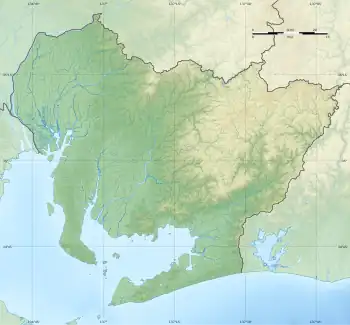| Masumida Shrine 真清田神社 | |
|---|---|
 Haiden of Masumida Shrine
| |
| Religion | |
| Affiliation | Shinto |
| Deity | Amenohoakari |
| Festival | April 3 |
| Location | |
| Location | 2-1 Masumida 1-chōme, Ichinomiya, Aichi 491-0043 |
 Shown within Aichi Prefecture  Masumida Shrine (Japan) | |
| Geographic coordinates | 35°18′27″N 136°48′07″E / 35.30750°N 136.80194°E |
| Architecture | |
| Date established | unknown |
| Website | |
| Official website | |
Masumida Shrine (真清田神社, Masumida Jinja) is a Shinto shrine in the Masumida neighborhood of the city of Ichinomiya in Aichi Prefecture, Japan. It is the ichinomiya of former Owari Province. The main festival of the shrine is held annually on April 3.[1]
Enshrined kami
The kami enshrined at Masumida Jinja is:
- Amenoho no Akari no mikoto (天火明命), kami of the sun and agriculture, the younger brother (or father) of Ninigi, and the ancestor of the Owari clan, the prehistoric rulers of the area.
History
The date of Masumida Shrine's foundation is unknown. Shrine tradition and the Kujiki records give the unlikely date of 628 BC, or the third day of the third month of the 33rd year in the reign of Emperor Jimmu, when the spirit of Amenohoakari was brought to Owari from the Mount Katsuragi in Yamato Province. Another tradition gives the date of foundation to the reign of the semi-legendary Emperor Suinin (97 BC – 30 BC). The shrine is located near the site of the provincial capital of Owari Province, established in the Nara period and features in the Yamato Takeru myth cycle. During the early Heian period, it appears in the Rikkokushi and in the Engishiki records. It has been styled as the ichinomiya of Owari Province since at least the end of the Heian period.
In 1584, after the shrine was damaged by an earthquake, it was rebuilt by Toyotomi Hideyoshi. It was subsequently supported by the Tokugawa shogunate and Owari Domain until the end of the Edo period. After the Meiji restoration, the shrine was given the rank of National shrine, 3rd rank (国幣小社, Kokuhei shosha) in the Modern system of ranked Shinto shrines in 1885. It was promoted a National shrine, 2nd rank (国幣中社, Kokuheii chusha) in 1914.[2] The shrine was destroyed in the Ichinomiya air raid of 1945 and was not rebuilt until 1951, with reconstruction taking ten years.[3]
The shrine is located ten-minutes on foot from either Owari-Ichinomiya Station on the JR Central Tōkaidō Main Line or Meitetsu Ichinomiya Station on the Kintetsu Railway Nagoya Main Line[4]
Gallery
 Rōmon
Rōmon Torii and Rōmon
Torii and Rōmon_honden.JPG.webp) Honden
Honden
Cultural properties
Important Cultural Properties
- Bugaku masks (木造舞楽面, Mokuzō bugaku-men), set of 12, ten from the Kamakura period, two from the Muromachi period, donation from Juntoku Tenno[5]
- 'Red Lacquerware (朱漆角切盤/朱漆入角盤/朱漆擎子 附(銅鋺/銅皿)), set of 25 items, including lacquer trays, saucers and bowls, dated 1457[6]
Registered Tangible Cultural Properties
See also
References
- Plutschow, Herbe. (1996). Matsuri: The Festivals of Japan. London: RoutledgeCurzon.ISBN 1-873-41063-8
- Ponsonby-Fane, Richard Arthur Brabazon. (1959). The Imperial House of Japan. Kyoto: Ponsonby Memorial Society. OCLC 194887
External links
- Official website (in Japanese)
- Aichi Prefecture tourist information
Notes
- ↑ Shibuya, Nobuhiro (2015). Shokoku jinja Ichinomiya Ninomiya San'nomiya (in Japanese). Yamakawa shuppansha. ISBN 978-4634150867.
- ↑ Ponsonby-Fane, Richard. (1959). The Imperial House of Japan, pp. 125.
- ↑ Yoshiki, Emi (2007). Zenkoku 'Ichinomiya' tettei gaido (in Japanese). PHP Institute. ISBN 978-4569669304.
- ↑ Okada, Shoji (2014). Taiyō no chizuchō 24 zenkoku 'Ichinomiya' meguri (in Japanese). Heibonsha. ISBN 978-4582945614.
- ↑ "木造舞楽面〈陵王一、納曽利一、還城楽一、/崑崙八仙三、童舞二、二ノ舞二、/貴徳一、散手一、〉" [Mokuzō bugaku-men] (in Japanese). Agency for Cultural Affairs. Retrieved August 20, 2020.
- ↑ "朱漆角切盤/朱漆入角盤/朱漆擎子}" [Shu urushi Tsunokiri-ban/ Shu urushi Iri Kakuban] (in Japanese). Agency for Cultural Affairs. Retrieved August 20, 2020.
- ↑ "真清田神社本殿及び渡殿" [Masumida jinja honden oyobi watadono] (in Japanese). Agency for Cultural Affairs. Retrieved August 20, 2020.
- ↑ "真清田神社北門及び透塀" [Masumida jinja kitamon oyobi Tōru hei] (in Japanese). Agency for Cultural Affairs. Retrieved August 20, 2020.
- ↑ "真清田神社祭文殿" [Masumida jinja saimonden] (in Japanese). Agency for Cultural Affairs. Retrieved August 20, 2020.